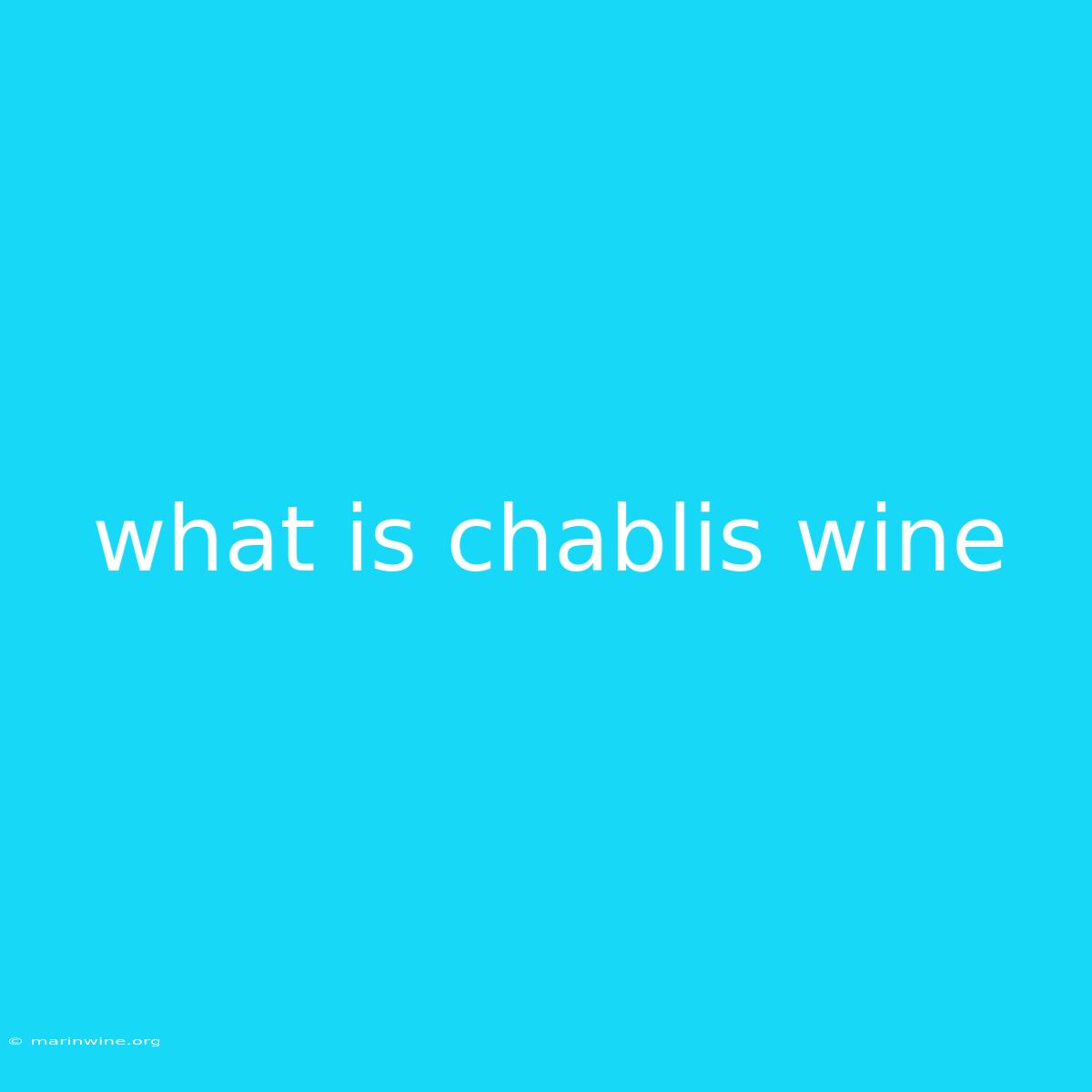What is Chablis Wine? Unveiling the Elegance of Chardonnay
Have you ever wondered what makes Chablis wine so special? It's not just another Chardonnay! This crisp, mineral-driven white wine from Burgundy, France, boasts a unique character that sets it apart.
Why It Matters: Understanding the world of Chablis unlocks a treasure trove of flavor, history, and appreciation for one of the most iconic wine regions in the world. This article explores everything you need to know about Chablis, from its distinct terroir to its captivating characteristics.
Key Takeaways of Chablis Wine:
| Key Takeaway | Description |
|---|---|
| Made solely from Chardonnay | Unlike other Burgundy wines, Chablis is exclusively made from Chardonnay. |
| Terroir defines the style | The chalky, Kimmeridgian soil of Chablis plays a crucial role in the wine's mineral character. |
| Crisp and refreshing | Chablis wines are known for their high acidity, making them a perfect pairing for seafood and salads. |
| Ranging in complexity | From entry-level Petit Chablis to Grand Cru wines, Chablis offers a diverse range of flavors and aging potential. |
Chablis Wine: Unveiling its Essence
What Makes Chablis Special?
Chablis stands out for its focus on Chardonnay, a grape variety renowned for its versatility. However, the true magic lies in its unique terroir. The Kimmeridgian soil, a unique type of chalky limestone found only in specific regions of Burgundy, plays a pivotal role in shaping the wine's characteristics. This soil imparts a distinctive minerality, which translates into flavors that are often described as flinty, oyster-like, or reminiscent of wet stones.
The Chablis Appellations: A Hierarchy of Flavor
Chablis is divided into four appellations, each offering a unique expression of the grape and terroir:
Petit Chablis: The entry-level appellation, known for its youthful and fruity style.
Chablis: The core appellation, producing a range of styles, from fresh and crisp to more complex and nuanced.
Chablis Premier Cru: Wines from these specific vineyards offer greater complexity and depth of flavor.
Chablis Grand Cru: The top tier, boasting the highest quality and aging potential, reflecting the best of the terroir.
The Winemaking Process: From Vine to Bottle
Traditional Methods: In Chablis, winemakers adhere to traditional techniques, emphasizing minimal intervention and preserving the natural flavors of the grapes.
Fermentation: Chardonnay grapes are typically fermented in stainless steel tanks, preserving their freshness and fruitiness.
Aging: While some Chablis wines are released young, others are aged in oak barrels for a period of time, adding complexity and roundness to the final product.
Exploring the Connection Between Chablis and its Terroir
The Kimmeridgian soil plays a crucial role in the character of Chablis wine. This chalky, fossilized seabed soil is rich in minerals, especially calcium, magnesium, and potassium. These minerals are absorbed by the vines and contribute to the minerality, acidity, and freshness that define Chablis.
The soil also affects the water retention of the vineyard, influencing the vine's growth and the grapes' concentration of flavors.
For example, the famous Grand Cru vineyard of Les Clos exhibits particularly chalky soil, resulting in wines with intense minerality, complexity, and longevity.
Chablis Wine: A Versatile Pairing
The crisp acidity and refreshing minerality of Chablis make it an ideal accompaniment to a wide range of dishes.
Food Pairings:
- Seafood: Chablis complements the delicate flavors of shellfish, oysters, and grilled fish.
- Salads: The acidity of the wine balances the richness of salads with creamy dressings.
- Chicken and white meats: The refreshing character of Chablis provides a clean palate after poultry dishes.
Frequently Asked Questions about Chablis
FAQ:
| Question | Answer |
|---|---|
| What is the best way to store Chablis? | Chablis should be stored in a cool, dark place, ideally at a temperature between 10-13°C (50-55°F). |
| How long can Chablis be aged? | The aging potential of Chablis varies depending on the appellation. Petit Chablis is best enjoyed young, while Grand Cru wines can age for decades. |
| What does Chablis taste like? | Chablis is known for its crisp acidity, citrusy flavors, and distinctive mineral character. It often exhibits notes of lemon, green apple, flint, oyster shell, and wet stones. |
| How do I choose the right Chablis for my meal? | Consider the style of dish you are serving. Lighter, more casual dishes pair well with Petit Chablis or Chablis, while more complex dishes benefit from Premier Cru or Grand Cru wines. |
| Is Chablis a dry wine? | Yes, Chablis is a dry wine, meaning it has no perceptible sweetness. |
Tips for Enjoying Chablis Wine
- Chill the wine: Chablis is best enjoyed chilled, ideally between 8-10°C (46-50°F).
- Use a white wine glass: The shape of a white wine glass helps to concentrate the aromas of the wine.
- Pair it with the right food: Consider the flavor profile of the dish and select a Chablis appellation that complements it.
- Enjoy it slowly: Chablis is a wine to savor, so take your time and appreciate its complex flavors.
Summary of Chablis Wine
Chablis is a remarkable wine that showcases the power of terroir. Its unique chalky soil and exclusive use of Chardonnay create a distinct style, known for its crisp acidity, refreshing minerality, and versatile pairing potential. Whether you are an experienced wine enthusiast or just starting your journey of discovery, Chablis offers an unparalleled experience.
Closing Message: Next time you're seeking a wine that embodies freshness, elegance, and the essence of French winemaking, reach for a bottle of Chablis. Its captivating story and exceptional flavors will leave you wanting more.

